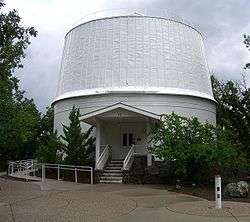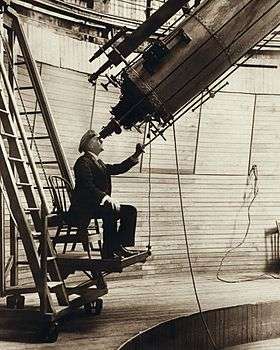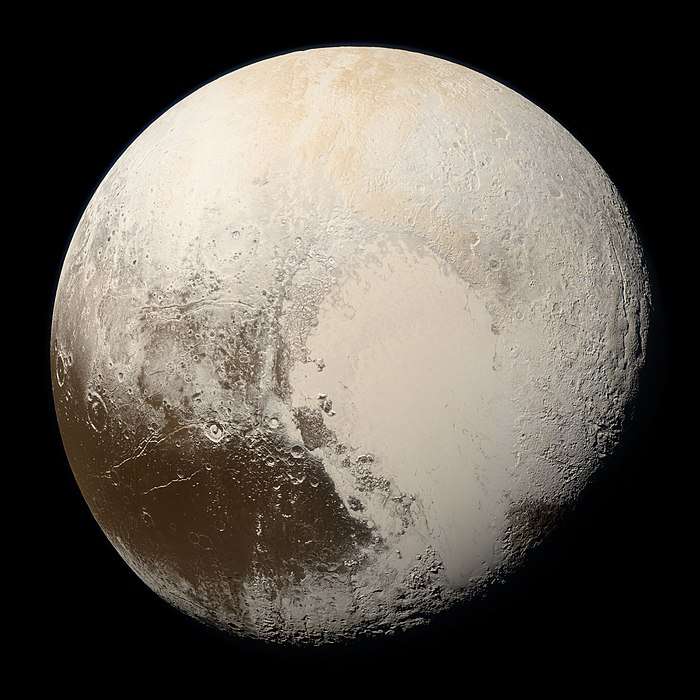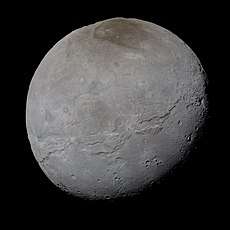Lowell Observatory
Lowell Observatory is now open BY RESERVATION ONLY. Please do not arrive without a reservation. Call (928) 774-3358 or visit www.lowell.edu/welcomeback for more information on our cautious approach to reopening.
 The Clark Telescope Dome on Mars Hill | |||||||||||||||||||||||||||||||||||||||||||||||||
| Organization | Private institution | ||||||||||||||||||||||||||||||||||||||||||||||||
|---|---|---|---|---|---|---|---|---|---|---|---|---|---|---|---|---|---|---|---|---|---|---|---|---|---|---|---|---|---|---|---|---|---|---|---|---|---|---|---|---|---|---|---|---|---|---|---|---|---|
| Observatory code | 690 | ||||||||||||||||||||||||||||||||||||||||||||||||
| Location | Flagstaff, Arizona | ||||||||||||||||||||||||||||||||||||||||||||||||
| Coordinates | 35°12′10″N 111°39′52″W | ||||||||||||||||||||||||||||||||||||||||||||||||
| Altitude | 2,210 m (7,250 ft) | ||||||||||||||||||||||||||||||||||||||||||||||||
| Established | 1894 | ||||||||||||||||||||||||||||||||||||||||||||||||
| Website | http://www.lowell.edu | ||||||||||||||||||||||||||||||||||||||||||||||||
| Telescopes | |||||||||||||||||||||||||||||||||||||||||||||||||
| |||||||||||||||||||||||||||||||||||||||||||||||||
 Location of Lowell Observatory | |||||||||||||||||||||||||||||||||||||||||||||||||
Lowell Observatory is an astronomical observatory in Flagstaff, Arizona, United States. Lowell Observatory was established in 1894, placing it among the oldest observatories in the United States, and was designated a National Historic Landmark in 1965.[2][3] In 2011, the Observatory was named one of "The World's 100 Most Important Places" by TIME. It was at the Lowell Observatory that the dwarf planet Pluto was discovered in 1930 by Clyde Tombaugh.
The observatory was founded by astronomer Percival Lowell of Boston's Lowell family and is overseen by a sole trustee, a position historically handed down through the family. The first trustee was Lowell's third cousin Guy Lowell (1916–1927). Percival's nephew Roger Putnam served from 1927 to 1967, followed by Roger's son Michael (1967–1987), Michael's brother William Lowell Putnam III (1987–2013), and current trustee W. Lowell Putnam.
Multiple astronauts attended the Lowell Observatory in 1963 while the moon was being mapped for the Apollo Program.[4]
The observatory operates several telescopes at three locations in the Flagstaff area. The main facility, located on Mars Hill just west of downtown Flagstaff, houses the original 61-centimeter (24-inch) Clark Refracting Telescope, which is now used for public education, with 85,000 annual visitors. The telescope, built in 1896 for $20,000, was assembled in Boston by Alvan Clark & Sons and then shipped by train to Flagstaff. Also located on the Mars Hill campus is the 33-centimeter (13-inch) Pluto Discovery Telescope, used by Clyde Tombaugh in 1930 to discover the dwarf planet Pluto.
In 2014, the 8,000 square feet (740 m2) Putnam Center was opened.[5] This observatory included many rooms with tools that were useful to observers including a library for research, a room for processing, photographic glass plates, multiple antique instruments used by previous astronomers, and many artifacts. The observatory does contain areas that are closed to the public view, although there are multiple places that tourists are welcome to visit. [6]
Lowell Observatory currently operates four research telescopes at its Anderson Mesa dark-sky site, located 20 km (12 mi) southeast of Flagstaff, including the 180-centimeter (72-inch) Perkins Telescope (in partnership with Boston University) and the 110-centimeter (42-inch) John S. Hall Telescope. Lowell is a partner with the United States Naval Observatory and Naval Research Laboratory in the Navy Precision Optical Interferometer (NPOI) also located at that site. The Observatory also operates smaller research telescopes at its historic site on Mars Hill and in Australia and Chile.
Past Anderson Mesa, on the peak of Happy Jack, Lowell Observatory built the 4.28-meter (169-inch) Lowell Discovery Telescope in partnership with Discovery Communications, Inc.
History
The observatory has carried out a wide array of research. One of its programs was the measurement of the variability of solar irradiance.[7] When Harold L. Johnson took over as the director in 1952, the stated objective became to focus on light from the Sun reflecting from Uranus and Neptune.[7] In 1953, the current 53 cm (21-inch) telescope was erected.[7] Beginning in 1954, this telescope began monitoring the brightness of these two planets, and comparing these measurements with a reference set of Sun-like stars.[7]
Beginning in 2012, Lowell Observatory began offering camps for children known as LOCKs (Lowell Observatory Camps for Kids). The first camp was established for elementary students. Later on, in 2013, they added an additional camp program for preschool children. The following year they added another program for middle school students. (“Kelly”, Manager at Lowell Observatory). Kids have the opportunity to learn hands-on about science, technology, engineering, and math (STEM) through a variety of activities that include games, experiments, story time, art, music, and more.
In 2016, Kevin Schindler published Lowell Observatory, a 128-page book containing over 200 captions and pictures. Arcadia Publishing’s Images of America included it in their series, which increased the enthusiasm of space in the public. The book itself features the popular reputation of Lowell Observatory, encompassing the revolutionary research of scientists and how they contributed to the field of astronomy.[8] [9]
 Percival Lowell in the observer's chair of the Alvan Clark 61 cm (24-inch) refractor
Percival Lowell in the observer's chair of the Alvan Clark 61 cm (24-inch) refractor Historic Clark telescope installed in 1896 and housed in a wooden dome resting on automobile tires.
Historic Clark telescope installed in 1896 and housed in a wooden dome resting on automobile tires.
Exhibits
- The Rotunda Museum: Built in 1916, it is used by the observatory as a library and collection area for artifacts. It features displays that discuss the Lowell family history and the discoveries made at the observatory. It also houses many different measuring tools including Thatcher’s Calculating Instrument.[10]
- Putnam Collection Center/ Lowell’s Lunar Legacy: When the Rotunda Museum is closed, the Putnam Collection Center and Lowell’s Lunar Legacy, are open to the public. The Center highlights the Observatories history and features artifacts from Lowell’s past and other scientific discoveries.[11]
- The Giovale Open Deck Observatory: It is the newest addition to the Lowell observatory that allows guest to learn astronomy during the day and night. It features six telescopes, six plinths on the deck’s circumference, and an APS spectrum display. The six telescopes on the deck are a 5.5-inch TEC wide-field refractor, an 8-inch Moonraker Victorian refractor, a 32-inch Starstructure Dobsonian reflector, a 16-inch Meade ACF catadioptric reflector, a 17-inch PlaneWave CDK catadioptric reflector, and a 14-inch PlaneWave CDK catadioptric reflector.[12]
Lowell Discovery Telescope
Lowell Observatory owns and operates the Lowell Discovery Telescope (LDT, formerly the Discovery Channel Telescope) located near Happy Jack, Arizona. This 4.3-meter reflecting telescope is the fifth-largest telescope in the contiguous United States and one of the most powerful in the world, thanks to a unique housing that can accommodate up to five instruments at the Ritchey-Chrétien focus. The LDT can switch between any of these instruments in about a minute, making it uniquely suited for time-domain programs as well as opportunity targets such as gamma ray bursts and supernovae.
The 6700-pound primary mirror measures 4.3 m (170 in) in diameter yet only about 10 cm (3.9 in) in thickness. This finely figured, thin meniscus mirror, held in shape by a 156-element active optics system, regularly delivers sub-arcsecond seeing. The mirror was ground and polished into its parabolic shape at the Optical Fabrication and Engineering Facility of the College of Optical Sciences of the University of Arizona in Tucson.
The LDT is housed in a 73-foot-tall, 62-foot-diameter metal dome located at an elevation of 7,800 feet (2,400 m) and about 40 miles (64 km) southeast of Flagstaff. Groundbreaking for the facility occurred on July 11, 2005. A little over six years later, the first image from just the primary mirror was recorded, using a small test camera mounted where the secondary mirror would eventually go. The secondary mirror was installed in January 2012. To celebrate first light, Lowell hosted a gala celebration on July 21, 2012, featuring a keynote address by Neil Armstrong. This was his final public appearance before his death several weeks later.
The telescope is named for the Discovery Channel television network. Discovery founder and CEO John Hendricks has long been a member of Lowell Observatory’s Advisory Board, and Discovery and John and his wife Maureen made gifts of $16 million toward the $53 million cost of the project. These were gifts, not purchases: Discovery has no ownership in the telescope, nor any direction of the research conducted with it. In return for their contributions, they received naming rights and first right of refusal for use of images in educational broadcasts. Research use proceeds as it would at any other professional telescope.
Boston University, the University of Maryland, the University of Toledo, Northern Arizona University, and Yale University have joined Lowell as partners with access to DCT.
Current research
Lowell Observatory's astronomers conduct research on a wide range of solar system and astrophysical topics using ground-based, airborne, and space-based telescopes. Among the many current programs are a search for near-Earth asteroids, a survey of the Kuiper Belt beyond Neptune, a search for extrasolar planets, a decades-long study of the brightness stability of the sun, and a variety of investigations of star formation and other processes in distant galaxies. In addition, the Observatory staff designs and builds custom instrumentation for use on Lowell's telescopes and elsewhere. For example, Lowell staff built a sophisticated high-speed camera for use on the Stratospheric Observatory for Infrared Astronomy (SOFIA). SOFIA is a joint project of NASA and DLR, the German space agency, and consists of a 2.5-meter (8.2-foot) telescope on board a Boeing 747 SP.
Discoveries
- The dwarf planet Pluto by Clyde Tombaugh in 1930
- Large recessional velocities of galaxies by Vesto Melvin Slipher between 1912 and 1914 (that led ultimately to the realization our universe is expanding)
- Co-discovery of the rings of Uranus in 1977
- The periodic variation in the activity of Comet Halley during the 1985/1986 apparition[13]
- The three largest known stars
- The atmosphere of Pluto
- Accurate orbits for two of Pluto's moons: Nix and Hydra
- Oxygen on Jupiter's satellite Ganymede
- Carbon dioxide ice on three Uranian satellites
- The first Trojan of Neptune
- Evidence that the atmosphere of HD 209458 b contains water vapor
See also
- List of largest optical telescopes in the continental United States
References
- "National Register Information System". National Register of Historic Places. National Park Service. January 23, 2007.
- "Lowell Observatory". National Historic Landmark summary listing. National Park Service. Retrieved September 27, 2007.
- Marilynn Larew (October 31, 1977). "National Register of Historic Places Inventory-Nomination: Lowell Observatory" (PDF). National Park Service. Retrieved May 5, 2009. Cite journal requires
|journal=(help) and Accompanying six photos, exterior, from 1964 and 1976 - "History". Lowell Observatory. Retrieved April 1, 2019.
- "Putnam Collection Center".
- "History". Lowell Observatory. Retrieved April 1, 2019.
- Wotkyns, Steele (2006). "Lowell Observatory's 21-inch Telescope Delivering Long-Term Results". Reflector. the Astronomical League. LVIII (2): 16.
- "History". Lowell Observatory. Retrieved April 3, 2019.
- "Lowell Observatory". www.goodreads.com. Retrieved April 3, 2019.
- "Museum Exhibits | Lowell Observatory in Flagstaff, AZ". Lowell Observatory. Retrieved November 12, 2019.
- "Museum Exhibits | Lowell Observatory in Flagstaff, AZ". Lowell Observatory. Retrieved November 12, 2019.
- "The Giovale Open Deck Observatory". Lowell Observatory. Retrieved November 12, 2019.
- Schleicher, David G.; Millis, Robert L.; Thompson, Don T.; Birch, Peter V.; Martin, Ralph; et al. (1990). "Periodic variations in the activity of Comet P/Halley during the 1985/1986 apparition". Astronomical Journal. 100: 896–912. Bibcode:1990AJ....100..896S. doi:10.1086/115570.
Sources
- Strauss D. (1994). "Lowell, Percival, Pickering, W.H. and the founding of the Lowell Observatory". Annals of Science. 51 (1): 37–58. doi:10.1080/00033799400200121.
- David Strauss, Percival Lowell: The Culture and Science of a Boston Brahmin (Cambridge: Harvard University Press, 2001)
- William Graves Hoyt, Lowell and Mars (Tucson: University of Arizona Press, 1976)
- William Lowell Putnam, The Explorers of Mars Hill: A Centennial History of Lowell Observatory, 1894–1994 (New Hampshire: Phoenix Publishing, 1994)
- https://lowell.edu/visit/locks/
External links
| Wikimedia Commons has media related to Lowell Observatory. |
- Lowell Observatory
- Lowell Discovery Telescope
- Flagstaff Clear Sky Clock Forecasts of observing conditions covering Lowell Observatory.
- National Historic Landmarks Program: Lowell Observatory+
Historic American Buildings Survey (photographic survey)
- Historic American Buildings Survey (HABS) No. AZ-206, "Lowell Observatory, 1400 West Mars Hill Road, Flagstaff, Coconino County, AZ"
- HABS No. AZ-206-A, "Lowell Observatory, Slipher Building"
- HABS No. AZ-206-B, "Lowell Observatory, Clark Dome"
- HABS No. AZ-206-C, "Lowell Observatory, Pluto Dome"
- HABS No. AZ-206-D, "Lowell Observatory, Mausoleum"
- HABS No. AZ-206-E, "Lowell Observatory, Water Tank"
- HABS No. AZ-206-F, "Lowell Observatory, Lodge"




